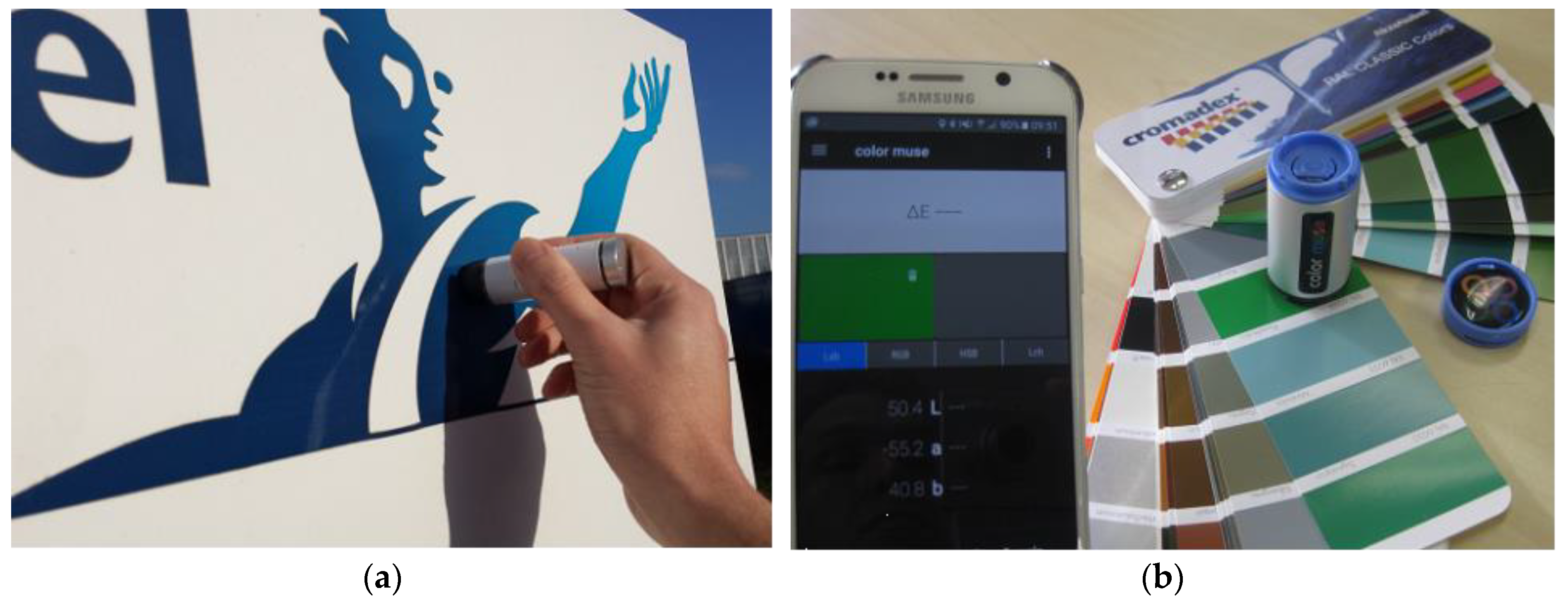Improving Color Accuracy of Colorimetric Sensors
Abstract
:1. Introduction
2. Materials and Methods
2.1. Spectral Power Distributions
2.2. Color Accuracy Compared to Spectrophotometer
2.3. Methods for Improving Color Accuracy
- LNode = c0 + c1(YBM)1/3 + c2YBM
- aNode = d0 + d1(XBM)1/3 + d2XBM + d3(YBM)1/3 + d4YBM
- bNode = e0 + e1(ZBM)1/3 + e2ZBM + e3(ZBM)1/3 + e4YBM
3. Results and Discussion
3.1. Results for the Node+ChromaPro
3.2. Results for the Color Muse
4. Conclusions
Author Contributions
Conflicts of Interest
References
- Berns, R.S.; Petersen, K.H. Empirical modeling of systematic spectrophotometric errors. Color Res. Appl. 1988, 13, 243–256. [Google Scholar] [CrossRef]
- Ohno, Y.; Hardis, J.E. Four-color matrix method for correction of tristimulus colorimeters. Color Imaging Conf. 1997, 1997, 301–305. [Google Scholar]
- Ohno, Y.; Brown, S.W. Four-color matrix method for correction of tristimulus colorimeters—Part 2. Color Imaging Conf. 1998, 1998, 65–68. [Google Scholar]
- Kosztyán, Z.T.; Eppeldauer, G.P.; Schanda, J.D. Matrix-based color measurement corrections of tristimulus colorimeters. Appl. Opt. 2010, 49, 2288. [Google Scholar] [CrossRef] [PubMed]
- Wee, A.G.; Lindsey, D.T.; Kuo, S.; Johnston, W.M. Color accuracy of commercial digital cameras for use in dentistry. Dent. Mater. 2006, 22, 553–559. [Google Scholar] [CrossRef] [PubMed]
- Orava, J.; Jaaskelainen, T.; Parkkinen, J. Color errors of digital cameras. Color Res. Appl. 2004, 29, 217–221. [Google Scholar] [CrossRef]
- León, K.; Mery, D.; Pedreschi, F.; León, J. Color measurement in L*a*b* units from RGB digital images. Food Res. Int. 2006, 39, 1084–1091. [Google Scholar] [CrossRef]
- Manufacturer Variable Inc. Available online: http://www.variableinc.com/ (accessed on 23 March 2018).
- NODE+Chroma Pro. Available online: https://www.kickstarter.com/projects/soldermaster/node-chroma-an-accurate-bluetooth-40-color-sensor (accessed on 18 April 2018).
- Konermann, A. NODE+Chroma: Changing the Way You Work+Design with Color. Print Magazine. Available online: http://www.printmag.com/design-inspiration/nodechroma-color-tool/ (accessed on 23 March 2018).
- Devarakonda, S.; Sevusu, P.; Liu, H.; Liu, R.; Iftode, L.; Nath, B. Real-time air quality monitoring through mobile sensing in metropolitan areas. In Proceedings of the 2nd ACM SIGKDD International Workshop on Urban Computing, Chicago, IL, USA, 11 August 2013; ACM: New York, NY, USA, 2013; pp. 1–8. [Google Scholar]
- NCS Colour PIN. Available online: http://ncscolour.com/product/ncs-colourpin-se/ (accessed on 23 March 2018).
- Color Muse. Available online: https://Color Muse.io/ (accessed on 23 March 2018).
- Yu, G.Y.; Temple, A.R.; Gasior, W. Computer-Implemented System and Method for Color Sensing, Storage and Comparison. U.S. Patent US20150296189A1, 2 November 2012. [Google Scholar]
- Yu, G.; Gasior, W.C. Modular Multi-Functional Device, Method, and System. U.S. Patent US9674323B1, 29 August 2013. [Google Scholar]
- Yu, G.Y.; Temple, A.R.; McGehee, J. Intelligent Alignment System and Method for Color Sensing Devices. U.S. Patent US20170131147A1 (WO2016178653A1), 1 May 2015. [Google Scholar]
- BYK Gardner, BYK-mac Instrument. Available online: https://www.byk.com/en/instruments/products/color-measurement.html (accessed on 23 March 2018).
- Lucideon Technologies, BCRA Tile Set. Available online: https://www.lucideon.com/materials-technologies/colour-standards (accessed on 23 March 2018).
- German Institute for Quality Assurance and Labeling, RAL. Available online: https://www.ral-farben.de/en/PRODUCTS-SHOP/RAL-CLASSIC/RAL-840-HR-primary-standards.html (accessed on 18 April 2018).


| Color Difference | BCRA Tiles | RAL Classic | RAL Design |
|---|---|---|---|
| Average | 2.23 | 1.84 | 1.16 |
| Maximum | 8.05 | 7.40 | 4.66 |
| Standard deviation | 2.00 | 1.18 | 0.66 |
| Number of samples | 39 | 167 | 199 |
| Color difference | BCRA Tiles | EIA Panels | RAL Design |
|---|---|---|---|
| Average | 2.57 | 2.12 | 1.68 |
| Maximum | 10.67 | 10.33 | 4.64 |
| Standard deviation | 2.53 | 1.57 | 0.75 |
| Number of samples | 26 | 46 | 199 |
| Color Accuracy | Node Uncorrected | Node Method B | Color Muse Uncorrected | Color Muse Method A |
|---|---|---|---|---|
| dECMC (1:1) < 0.5 | 5.4% | 21.9% | 7.5% | 22.5% |
| dECMC (1:1) < 1.0 | 28.3% | 58.2% | 23.5% | 62.5% |
| dECMC (1:1) < 1.5 | 51.5% | 79.4% | 52.6% | 82.2% |
| dECMC (1:1) < 2.0 | 71.1% | 86.5% | 76.4% | 90.8% |
| dECMC (1:1) < 3.0 | 88.0% | 93.3% | 88.2% | 93.4% |
| dECMC (1:1) < 5.0 | 95.4% | 96.8% | 93.4% | 96.7% |
| dECMC (1:1) < 10.0 | 99.4% | 99.8% | 100% | 100% |
© 2018 by the authors. Licensee MDPI, Basel, Switzerland. This article is an open access article distributed under the terms and conditions of the Creative Commons Attribution (CC BY) license (http://creativecommons.org/licenses/by/4.0/).
Share and Cite
Kirchner, E.; Koeckhoven, P.; Sivakumar, K. Improving Color Accuracy of Colorimetric Sensors. Sensors 2018, 18, 1252. https://doi.org/10.3390/s18041252
Kirchner E, Koeckhoven P, Sivakumar K. Improving Color Accuracy of Colorimetric Sensors. Sensors. 2018; 18(4):1252. https://doi.org/10.3390/s18041252
Chicago/Turabian StyleKirchner, Eric, Pim Koeckhoven, and Keshav Sivakumar. 2018. "Improving Color Accuracy of Colorimetric Sensors" Sensors 18, no. 4: 1252. https://doi.org/10.3390/s18041252
APA StyleKirchner, E., Koeckhoven, P., & Sivakumar, K. (2018). Improving Color Accuracy of Colorimetric Sensors. Sensors, 18(4), 1252. https://doi.org/10.3390/s18041252




